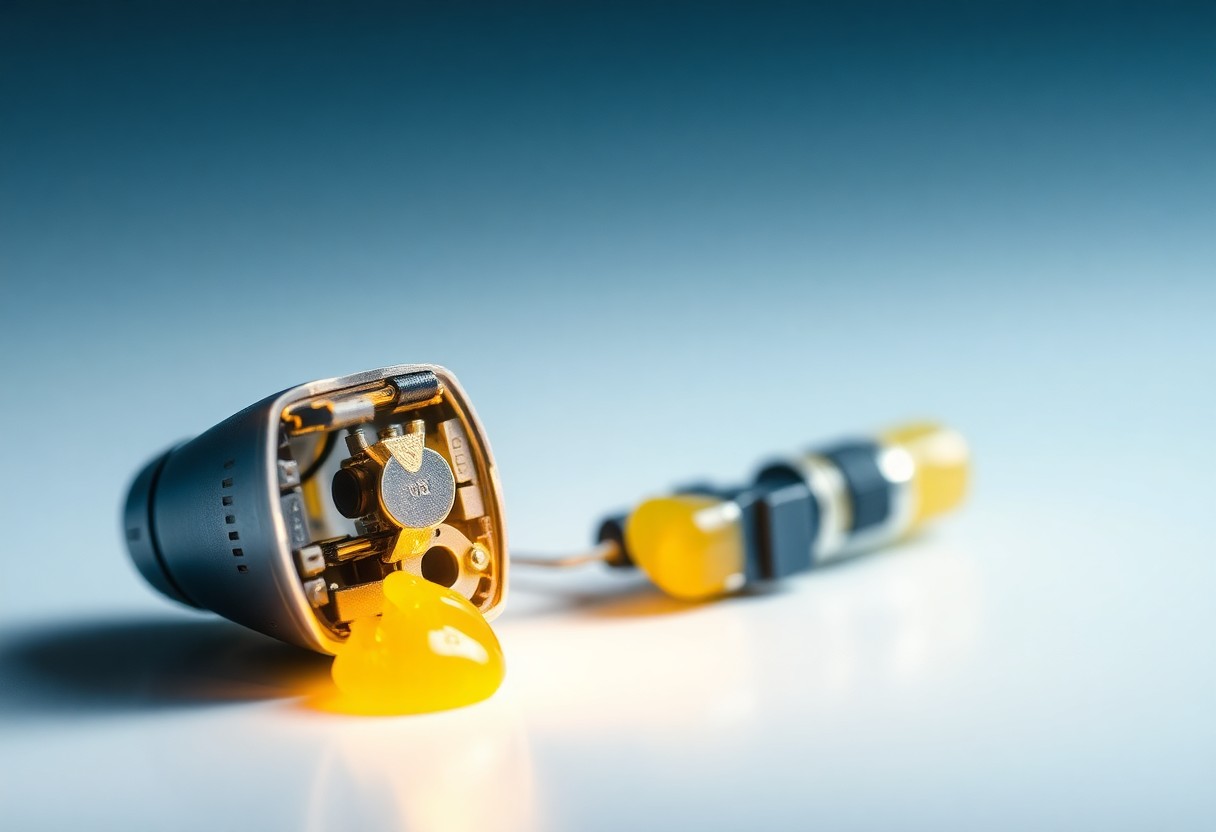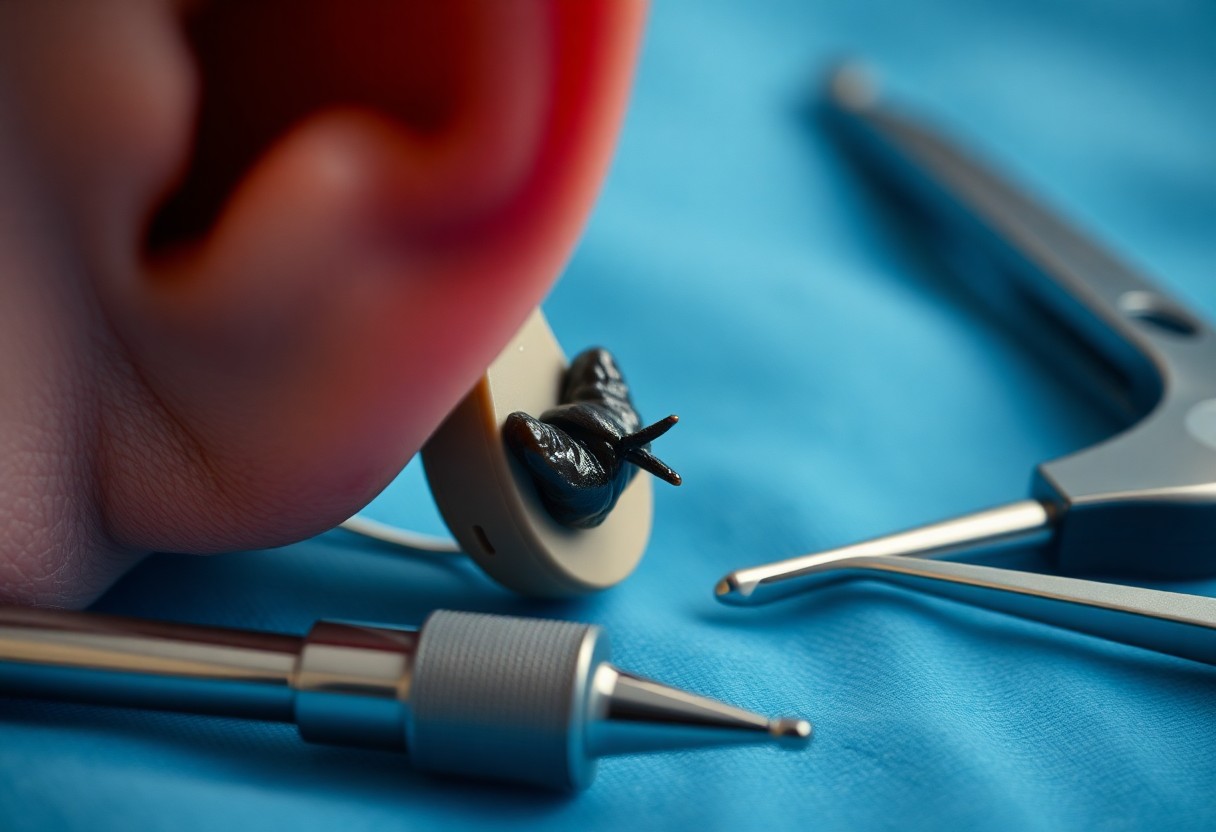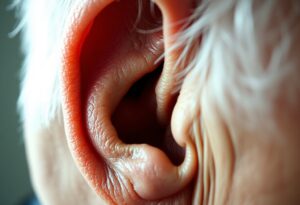Many people who use hearing aids experience issues with sound quality due to the buildup of viscous ear wax. This natural substance, while protecting your ear canal, can become problematic when it accumulates and obstructs the sound ports of your device. Understanding how ear wax interacts with your hearing aids can help you maintain optimal performance and ensure clear sound. In this post, we will explore the reasons behind this obstruction and offer tips for effective cleaning and maintenance.
Key Takeaways:
- Viscous ear wax can accumulate and block sound ports, leading to reduced sound transmission from the hearing aid.
- Thicker ear wax may be less easily removed, necessitating more frequent maintenance of hearing aids.
- Regular cleaning and monitoring of ear wax levels can help ensure optimal hearing aid performance.

The Anatomy of a Hearing Aid and Its Vulnerabilities
Key Components of Hearing Aids
Hearing aids consist of several key components: a microphone that captures sound, an amplifier that increases the sound’s volume, a receiver that converts amplified signals back into sound waves, and a battery that powers the device. Each element plays a vital role in ensuring that you can hear clearly, but they also introduce areas where problems can arise, particularly in terms of wax buildup and moisture exposure.
How Sound Ports Function in Hearing Aids
Sound ports in hearing aids are designed to channel incoming sounds directly to your ear canal. They act as entry points for sound waves, which are processed by the microphone and amplified before reaching the receiver. The design ensures that sound travels efficiently, but it also makes them susceptible to blockage from debris, such as ear wax.
Sound ports often feature a mesh or grille, designed to filter out larger particles while allowing sound to flow freely. However, if viscous ear wax accumulates, it can easily clog these openings, diminishing the quality of sound you receive. Regular maintenance is necessary to prevent this buildup; cleaning the sound ports with a soft brush or cloth can restore optimal performance. Cases of significant blockage may require professional cleaning, ensuring your hearing aids can function effectively at all times.
The Nature of Ear Wax: More Than Just an Annoyance
Understanding the Composition of Ear Wax
Ear wax, scientifically known as cerumen, is a complex mixture of secretions, dead skin cells, and environmental debris. It primarily consists of lipids, fatty acids, and alcohols, which give it its sticky texture. This natural wax plays an imperative role in your ear health by trapping dirt and bacteria, while also providing a waterproof barrier that keeps moisture out of the ear canal.
Variations in Ear Wax Consistency and Production
Your ear wax can vary significantly in consistency—from dry and flaky to thick and sticky—largely due to genetic factors, diet, and environment. Studies suggest that people of Asian descent typically produce drier ear wax, while those of African and European descent often have wetter forms. This variability affects how easily ear wax may build up and obstruct hearing aid sound ports.
Factors influencing ear wax consistency include hydration levels as well as hormonal changes, which can affect gland function. For instance, a high-fat diet may lead to more viscous ear wax due to increased lipid production. Moreover, environmental conditions such as humidity can also impact ear wax formation. Individuals who swim frequently may experience more watery ear wax, whereas those living in arid climates may find their ear wax is thicker, both of which could lead to different risks for hearing aid obstruction.
The Impact of Viscous Ear Wax on Sound Transfer
How Viscosity Affects Sound Quality
The thickness or viscosity of ear wax directly influences its ability to transmit sound effectively. When ear wax becomes more viscous, it creates a denser barrier that sound waves struggle to penetrate. This density can lead to a muffled listening experience, causing your hearing aids to perform poorly, ultimately resulting in distorted or diminished sound quality.
The Acoustic Properties of Ear Wax and Their Consequences
The unique composition of ear wax affects its acoustic properties, which play a pivotal role in sound transmission. Viscous ear wax can absorb sound waves instead of allowing them to pass through, leading to increased attenuation of sound. This effect can vary based on the thickness and moisture content of the ear wax, making regular maintenance necessary for optimal hearing aid function.
Common Symptoms of Hearing Aid Sound Port Obstruction
Recognizing Performance Issues in Aids
When your hearing aid begins to lose sound quality or becomes intermittently muffled, performance issues may arise from sound port obstruction. This can manifest as weaker amplification or a loss of clarity in voices and ambient sounds, making it challenging to engage in conversations or enjoy your environment fully.
Understanding the Psychological Effects of Hearing Loss
The impact of hearing loss extends beyond physical symptoms; the psychological effects can deeply influence your daily life. Social isolation, increased anxiety, and a decline in self-esteem often accompany the struggle to communicate effectively.
Feelings of frustration and embarrassment may arise when you can’t participate in conversations or misunderstand what’s being said. These emotional responses can lead to withdrawal from social situations, worsening loneliness and affecting mental health. Studies show that untreated hearing loss may contribute to cognitive decline, making it even more vital to address the physical symptoms and their underlying causes, like sound port obstructions.

The Troublesome Cycle: Wax Buildup and Hearing Aid Function
The Mechanism of Ear Wax Accumulation
Ear wax, or cerumen, accumulates due to several factors including skin cell shedding, excessive oil production, and environmental exposure. Your body’s natural process of producing wax is meant to protect the ear canal, but when combined with the use of hearing aids, the wax can become compacted. The design of your hearing aids can contribute to trapping wax, leading to a buildup that obstructs sound ports and impairs auditory performance.
Effects of Hearing Aid Use on Ear Wax Production
Your hearing aids can inadvertently stimulate increased ear wax production. When you wear hearing aids, they create a seal within the ear canal, leading to a moisture-rich environment that can enhance cerumen production. Over time, this increased production can exacerbate ear wax buildup, especially if the aids are not regularly cleaned. This cycle can cause not only hearing difficulties but also the potential for ear infections as the natural balance within the ear canal is disrupted.
Studies indicate that individuals who use hearing aids regularly may experience up to a 50% increase in cerumen production compared to non-users. This effect is heightened in users who have tighter-fitting devices. Keeping your hearing aids clean is important to breaking the cycle of wax accumulation, as it helps minimize the moisture that promotes wax buildup and ensures optimal performance of your aids. Regular maintenance and scheduled cleanings can significantly reduce issues associated with wax interference, leading to clearer sound and an overall improved auditory experience.
Practical Solutions: Managing Ear Wax for Optimal Hearing Aid Performance
Cleaning and Maintenance Techniques for Hearing Aids
Regular cleaning of your hearing aids is necessary for optimal performance. Use a soft, dry cloth to wipe the external surfaces daily, and employ specialized tools such as a wax picker or brush to keep the sound ports clear. Avoid using water or cleaning solutions that could damage electronic components. Schedule a deep cleaning every few weeks, either by yourself or through your audiologist, to help maintain functionality and extend the life of your devices.
When to Seek Professional Assistance
Consulting a professional becomes necessary if you notice persistent sound issues despite thorough cleaning. If wax buildup has led to significant obstruction, or if your hearing aids show signs of damage, assistance from an audiologist or hearing specialist can provide the necessary evaluation and solutions tailored to your needs.
Professional assistance is especially necessary if ear wax blockages cause discomfort or impact hearing aid performance significantly. An audiologist can assess the extent of the blockage and provide appropriate treatments, such as ear wax removal, which might include irrigation or suction techniques. Additionally, if you experience frequent issues with ear wax accumulation, your specialist can discuss personalized strategies to minimize future problems, ensuring your hearing aids function effectively.
Innovations in Hearing Aid Design to Combat Wax Interference
Advances in Hearing Aid Technology
Recent strides in hearing aid technology have focused on minimizing wax interference. Manufacturers are now implementing features such as sound port filters and more robust designs that better resist moisture and wax accumulation. This ensures clearer sound delivery, improving your overall listening experience. Enhanced digital signal processing helps to filter background noise, allowing you to focus more on conversations and reducing the impact of any wax obstruction that may occur.
Future Trends: Nano-coatings and Self-Cleaning Features
The future of hearing aids lies in the development of nano-coatings and self-cleaning technologies. These innovations aim to repel earwax and moisture, ensuring that the sound ports remain clear longer, preventing the hassle of manual cleanings.
For instance, nano-coatings utilize advanced materials that create a hydrophobic barrier, effectively pushing away moisture and debris. This could lead to lasting improvements in the performance of your hearing aids. Self-cleaning features are also being explored, such as mechanisms that periodically vibrate or utilize micro-pumps to dislodge wax buildup. Such advancements promise a significant reduction in maintenance needs, giving you a worry-free experience with your devices.
Expert Perspectives: Insights from Audiologists
Approaches Audiologists Recommend for Ear Wax Management
Audiologists suggest a variety of methods for managing ear wax effectively. Regular cleaning with a soft cloth and the use of over-the-counter drops can help soften wax buildup. For more significant issues, professionals may recommend mineral oil or saline solutions. In cases of severe blockage, you might need to visit an audiologist for irrigation or suction removal to prevent damage to your hearing aids and ensure optimal sound quality.
The Importance of Regular Hearing Evaluations
Regular hearing evaluations play a vital role in maintaining your auditory health. These assessments help audiologists monitor any changes in your hearing abilities and detect issues related to ear wax buildup early. With consistent check-ups, you can customize your hearing aids and ensure that they remain effective, allowing for timely adjustments based on your evolving needs.
Having a hearing evaluation at least once a year allows audiologists to assess both your auditory function and ear canal health, including the presence of wax. For individuals wearing hearing aids, biannual evaluations are often advised. This proactive approach supports the early detection of potential problems, ensuring your hearing aids perform at their best while addressing any complications that may arise from ear wax accumulation.
Final Words
So, if you have viscous ear wax, it can easily obstruct the sound ports of your hearing aid, impacting its performance. This buildup can create barriers between the device and your ear, causing muffled sounds or reduced amplification. Regular cleaning and maintenance of both your hearing aid and your ears are imperative to prevent this issue. By managing ear wax effectively, you can ensure optimal sound quality and a better hearing experience.
FAQ
Q: Why does viscous ear wax obstruct hearing aid sound ports?
A: Viscous ear wax can accumulate in the ear canal and adhere to the sound ports of hearing aids, blocking sound transmission and affecting performance.
Q: How does the consistency of ear wax affect hearing aids?
A: The thickness of viscous ear wax can create a seal in the sound ports, preventing sound waves from reaching the hearing aid’s microphone and altering auditory perception.
Q: What impact does temperature have on ear wax viscosity?
A: Higher temperatures can soften ear wax, causing it to flow more easily; however, if it remains thick, it can still obstruct sound ports even in warmer conditions.
Q: How can users prevent ear wax from blocking hearing aid sound ports?
A: Regular cleaning of hearing aids, using wax guards, and consulting with audiologists for ear wax management can help reduce the risk of blockage.
Q: What should be done if hearing aid sound ports are obstructed by ear wax?
A: Users should turn off the hearing aid, gently clean the sound ports with appropriate tools, and seek professional help if obstruction persists.



